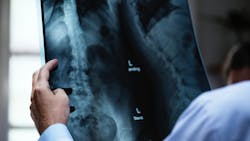FDA approves treatment for children with progressive idiopathic scoliosis
The Food and Drug Administration announced the approval of The Tether - Vertebral Body Tethering System to Zimmer Biomet Spine – the first spinal tether device intended to be used in children and adolescents to correct the most common form of scoliosis, called idiopathic scoliosis, that has not responded to conservative treatment options, such as external bracing.
Idiopathic scoliosis is a sideways curvature of the spine whose cause is unknown. It is the most common spinal deformity in children and is most often diagnosed between ages 10 to 18, although it may occur at a younger age.
The device is intended to treat growing children and adolescents whose spinal curves are approaching or have reached the range where surgical treatment is an option.
The standard treatments for idiopathic scoliosis among children and adolescents who are still growing are conservative, non-surgical treatments such as external bracing to help correct the spinal curvature. Approximately 6,800 patients in the U.S. each year will develop progressive curvatures that do not respond to bracing. For these patients, spinal fusion surgery (i.e., spinal implants to correct the curvature of the spine and fusion surgery) may be used to permanently stabilize and correct spinal curvatures. While spinal fusion is often successful, this surgery permanently restricts the motion of the spine and may have long-term complications such as pain, arthritis and future spinal deformities, which could require additional surgical treatment.
The Tether – Vertebral Body Tethering System provides an alternative for patients with idiopathic scoliosis that doesn’t respond to bracing. As a patient grows, The Tether – Vertebral Body Tethering System is designed to continue to correct the curvature while maintaining a fuller range of motion when compared to spinal fusion procedures.
The Tether – Vertebral Body Tethering System includes anchors and vertebral body screws that are placed into the same side of each vertebra in the curved section of the spine through an incision on the side of the chest. A flexible cord, called a tether, is connected to the screws. Tension is applied to the tether during surgery to compress one side of the spine and to partially correct the curve. Over time, the tether slows growth on the curved side of the spine and promotes growth on the opposite side. This provides additional correction of the curve as the patient continues to grow.
The Tether - Vertebral Body Tethering System is not intended to be removed unless certain problems, such as overcorrections, develop. Health care professionals will monitor patients, conducting follow-up x-rays, to track the spinal curvature and identify any potential problems that might require additional surgery to revise or remove the device. For those patients whose curves are not adequately corrected by The Tether – Vertebral Body Tethering System, spinal fusion surgery is still possible.
The FDA reviewed data for The Tether – Vertebral Body Tethering System through the humanitarian device exemption (HDE) process. A Humanitarian Use Device (HUD) is a device intended to benefit to patients by treating or diagnosing a disease or condition that affects not more than 8,000 individuals in the U.S. per year.
The FDA reviewed clinical data supporting the safety and probable benefit of The Tether – Vertebral Body Tethering System from 57 patients who received the device. At two years, 43 patients had sufficient improvement of the curvature of their spines and did not need spinal fusion. The most common serious adverse events observed included overcorrection of the curvature, tether breakage, and pneumothorax or air leakage into the space between the lung and chest wall. General complications consistent with any spinal surgical procedure were also noted including pain, respiratory problems, nerve injuries and bleeding.
Zimmer Biomet Spine has shared with the FDA that it will be partnering with the Harms Study Group, a cohort of surgeons dedicated to the advancement of treatment for children and adolescents with spinal deformities, to develop a patient data registry to help assess the long-term performance of The Tether System.
